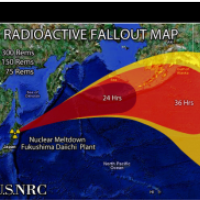Fukushima Radiation Detected off the West Coast
 Fukushima radioactivity map (graphic: Nuclear Regulatory Commission)
Fukushima radioactivity map (graphic: Nuclear Regulatory Commission)
Run for your lives. Radiation from the failed Fukushima Dai-ichi Nuclear Power Plant (FD-NPP) in Japan has finally arrived in U.S. waters off the West Coast.
Despite warnings from some quarters that the March 2011 nuclear meltdown, following a hurricane and tsunami, would send tons of radioactive water in our direction and contaminate our air via the Pacific jet stream, scientists monitoring the arrival have downplayed any ill effects.
Scientists at Woods Hole Oceanographic Institution, which organized the crowdsourced science project to track the radiation’s journey across the Pacific in the absence of official U.S. monitoring, said minute traces of cesium-134 were collected about 100 miles off the coast of Eureka in August.
Ken Buesseler, an oceanographer and project organizer at Woods Hole, said the levels detected were so low, a person swimming in the water there for six hours would encounter radiation equivalent to having a dental x-ray. Put another way, the contamination level is 1,000 times lower than acceptable drinking water standards.
But it’s not nothing and could become more concentrated over time. The Fukushima reactor is still leaking and the potential for even more serious problems exist. Buesseler said there is definitely no threat to swimmers off the West Coast and if someone wants to swim near Fukushima, they could get within one kilometer before encountering a problem.
The project website lists 39 organizations that are helping, including the University of Hawaii, the University of California, Davis, Marine Pollution Studies Lab, Humboldt State University Marine Lab and Santa Barbara Channel Keeper. Monitoring is done at 28 locations, from Costa Rica to British Columbia and Alaska.
A similar finding of trace radiation was made in February off the Canadian coast by John Smith, a scientist at Fisheries and Oceans Canada in Dartmouth, Nova Scotia. Although Buesseler plays down the present danger from Fukushima, he and Smith are currently working on a separate project together to determine what risks, if any, the radiation poses for Canada’s coastal region.
That project, Fukushima InFORM, involves the Canadian government, academic groups and non-governmental organizations under the direction of Jay Cullen at the University of Victoria, Canada. The project’s website notes that “concentrations of FD-NPP derived radionuclides and their associated heath risks are expected to increase in the coming 3-4 year period.”
Although the radiation was detected months ago, Buesseler could not say when it might actually wash up onshore “because the mixing of offshore surface waters and coastal waters is hard to predict. Mixing is hindered by coastal currents and near-shore upwelling of colder deep water.”
In the meantime, extraordinary resources are being brought to bear on monitoring a situation that its participants say “poses little risk to human health.” The continued keen interest may have to do with the ongoing disaster on the other side of the ocean. The reactors at Fukushima are still unstable, radiations levels are at all-time highs and Japan has no better ideas for ending the crisis that they did three and a half years ago.
–Ken Broder
To Learn More:
Fukushima Radiation Is Hitting The US West Coast. Here’s Why You Shouldn’t Freak Out (by Gwynn Guilford, Quartz)
Oceanographers detect Fukushima Radiation in Pacific Ocean off California’s Coast (by Andrea Cordell, Uncover California)
Fukushima Radioactivity Detected Off West Coast (Center for Marine and Environmental Radioactivity)
California: Ground Zero for Fukushima Radiation? (by Adrianne Hill, Guardian Liberty Voice)
Researchers Predict Radiation from Fukushima Nuclear Disaster to Hit U.S. West Coast by April (by Noel Brinkerhoff and Ken Broder, AllGov California)
- Top Stories
- Controversies
- Where is the Money Going?
- California and the Nation
- Appointments and Resignations
- Unusual News
- Latest News
- California Forbids U.S. Immigration Agents from Pretending to be Police
- California Lawmakers Urged to Strip “Self-Dealing” Tax Board of Its Duties
- Big Oil’s Grip on California
- Santa Cruz Police See Homeland Security Betrayal in Use of Gang Roundup as Cover for Immigration Raid
- Oil Companies Face Deadline to Stop Polluting California Groundwater





